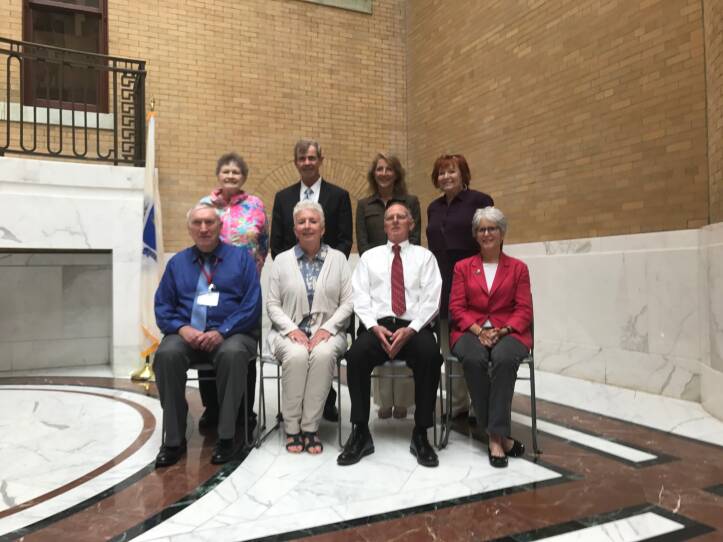Our setting for today's Curiosity Desk is one of my favorite rooms in the whole of the city of Boston: The Great Hall of the Massachusetts State House.
Joining me in this tri-colored marble room, beneath huge flags representing more than 300 Bay state towns are some 40 people, gathered to wrap up their 48th season and be lauded for a job well done.
This is the annual meeting of the Doric Docents, an organization that for nearly half a century has offered free tours of the Massachusetts State House to countless students, residents, tourists and foreign dignitaries.
"The Docents are a wonderful group of adult volunteers who welcome visitors in a very special and unique way," said Director of State House Tours Mary Rinehart, who supervises the program. "Many of these Docents have been with us for 20 or more years, so they’re very devoted and loyal."

The group was started as the Doric Dames in 1969 by Jessie Sargent, wife of then-governor Francis Sargent. They were renamed the Doric Docents in 1999, when they first let men join the program. Today, as at the start, the honorary president is the governor’s wife.
"I like to say that it’s my greatest unearned honor to be the President of the Doric Docents," said Massachusetts’ current first lady, Lauren Baker, who was on hand for the annual meeting. "I couldn’t begin to hold a candle to the knowledge and skill that the Docents bring to their jobs every day."
Remember the Latin root for the word docent: doce docere, to teach. And you really are a teacher.
So, just who are these Doric Docents?
Most of them are retirees. They come from all over the state: Boston, Reading, Andover. They are former book store employees, Harvard administrators and high school principles. What do they have in common? A love of the Commonwealth, its history and an urge to share.
"Remember the Latin root for the word docent: 'doce docere', to teach," said 15-year Docent Joe Ponti. "And you really are a teacher."
And what teacher could ask for a better classroom? A building echoing with centuries of history; art work ranging from stately portraits to sculptures of American titans to relics of the American Revolution. Not to mention the building itself: Charles Bulfinch’s masterpiece of Federal architecture.
And yet, for all that grandeur, the Docents tell me that – more often than not – the star of their tours? Democracy in action.
"It’s a living museum," said Ponti. "They love the Senate chamber."
"When you go to the House and Senate, people are really interested in the procedures," added Dorothy Sullivan, a longtime Docent.
This small band of volunteers not only manages the day-to-day of the program – they also keep the ranks filled with new recruits, which is not as easy as it might seem.
"Actually, it’s quite rigorous," explained Ellen Carpenter, who's been a Docent for three years. She says there’s plenty to be learned in order to become a Doric Docent, but the real challenge is the final one before certification – designing your own tour for an audience of one: the boss, Mary Rinehart.
"You have to go around and give her a tour," began Carpenter, then hesitated.
"Is that a nerve-wracking moment?" I asked.
"Yes it was, actually, it was. It was nerve-wracking," she replied.
And what does Mary Rinehart think of that?

"Well, as I tell them, I don't bite," said Rinehart, laughing. "But we do have a responsibility to be accurate with our facts and make sure that they have all the necessary information."
Rinehart says that “design your own" aspect ensures that no two State House tours are exactly the same – the unique trademark of the Doric Docents.
"They have their own sense of history, their own areas of specialty and interest," she said of the Docents. "They, of course, have had lots of life experience so they can interact with people about historical events that they personally have witnessed. They all bring those different interests and specialties to the tour in addition to the basic facts."
I don't think we'd have the appreciation of our capital that we have without them and their activities over all these years.
About 100,000 people visit the State House each year. And that this stable of volunteers stands ready to personally welcome them is something that Secretary of the Commonwealth William Galvin, who stopped by to offer his thanks, says is remarkable.
"This has been our capital now for over 200 years and it’s really the centerpiece of our government," he said. "And giving people not just the opportunity to view it but also to explain the history of so much of it is very important. I don’t think we’d have the appreciation of our capital that we have without them and their activities over all these years.
And that they are average citizens offering their time and expertise to share a part of Massachusetts’ story with the young and old, free of charge? Well, what could be more democratic?





